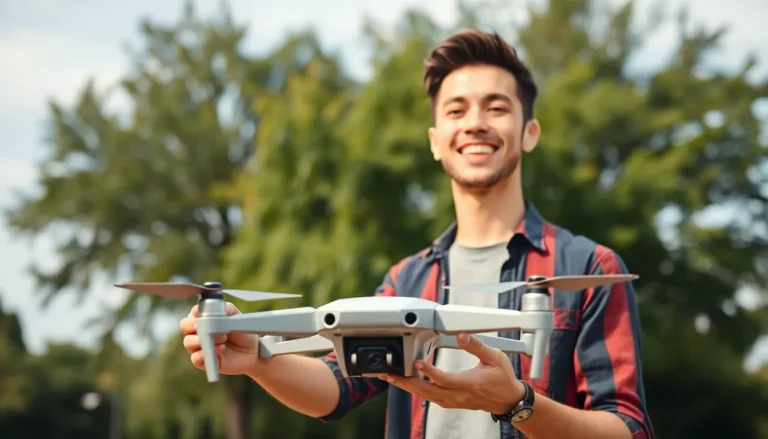Table of Contents
ToggleDrones are buzzing above us like a swarm of over-caffeinated bees, and it’s hard not to notice. From delivering packages faster than you can say “Amazon Prime” to capturing stunning aerial views for social media, these flying gadgets have taken to the skies in a big way. But while they might seem like the coolest tech toy around, there’s a whole lot more going on behind those propellers.
As drones become a common sight in our lives, they raise questions about privacy, safety, and even the future of transportation. Are they harmless helpers or a potential nuisance? Buckle up as we explore the fascinating world of drones over us, where technology meets everyday life in ways that could make even George Jetson jealous. Get ready for a flight through innovation, regulations, and the quirky side of drone culture.
Overview of Drones Over Us
Drones increasingly occupy airspace in urban and rural areas. Their uses span various sectors, including agriculture, construction, and law enforcement. Industries leverage drones for tasks like crop monitoring, infrastructure inspection, and surveillance. The versatility of drones contributes to significant growth in their applications.
Privacy concerns arise with widespread drone usage. Many individuals worry about surveillance and data collection without consent. Regulations vary by region, impacting how drones operate in populated areas. Companies must navigate these laws to balance innovation with public safety.
Safety remains a top priority as drones become more common. Reports indicate a rise in drone incidents, prompting discussions about regulations and operational guidelines. Implementing clear rules reduces risks associated with drone flights, ensuring safer skies for everyone.
Consumer drones also gain popularity for personal use. Hobbies such as photography and videography see increased interest in drone technology. Alongside creativity, users encounter challenges with flying laws, requiring education on responsible use.
The future of drones envisions further integration into daily life. Innovations may include advanced navigation systems and greater automation. With ongoing advances, drones could enhance multiple aspects of transportation, possibly transforming how goods and services reach consumers.
The Evolution of Drone Technology
Drone technology has undergone significant transformation, progressing from basic remote-controlled models to sophisticated flying machines essential in various fields. Innovations continue to drive their integration into everyday life.
Early Developments
Military applications marked the initial phase of drone technology. During World War I, the concept of unmanned aerial vehicles emerged. These rudimentary drones served primarily for reconnaissance. The following decades saw gradual improvement, with notable advancements in control systems and design. By the 1990s, drones began gaining traction in military operations, including surveillance and target acquisition.
Modern Advancements
Recent breakthroughs have revolutionized drone capabilities. Improved sensors, GPS systems, and artificial intelligence enhance operational efficiency. Today, drones perform tasks in diverse sectors such as agriculture, where they monitor crops and manage irrigation. The commercial market has flourished, with consumer drones popular for photography and videography. Regulatory frameworks have also evolved, addressing safety and privacy concerns as drone technology becomes ubiquitous.
Impact of Drones on Society
Drones increasingly influence various aspects of everyday life, bringing both benefits and significant concerns.
Benefits of Drones
Drones enhance efficiency across many industries. Agriculture employs drones for monitoring crop health, identifying issues, and optimizing yields. Construction teams use drones to survey job sites quickly and create accurate 3D models. In disaster response, drones provide real-time aerial views, helping responders assess damage and locate victims faster. Package delivery systems leverage drones to streamline logistics, significantly reducing delivery times. Individuals enjoy drones for photography and videography, capturing stunning aerial imagery. With improved technology, many sectors adopt drones, increasing productivity while offering innovative solutions.
Concerns and Challenges
Privacy issues emerge as drones traverse populated areas. Individuals express unease about unauthorized surveillance and data collection. Regulations differ significantly across regions, complicating compliance for drone operators. Safety represents a pressing challenge, as incidents involving drones impact public trust. Reports of near-misses with manned aircraft increase calls for stricter operational guidelines. Additionally, maintenance and battery life pose concerns, particularly for commercial users. Educating both drone operators and the public provides a path forward in addressing these challenges, ensuring responsible drone integration into society.
Regulations Surrounding Drones Over Us
Drones increasingly influence regulations to address safety and privacy concerns. Various guidelines shape drone operations across jurisdictions, which significantly impacts usage in populated areas.
Current Legislation
The Federal Aviation Administration (FAA) oversees drone regulations in the United States, implementing rules for commercial and recreational users. Current legislation, such as Part 107, mandates that drone operators maintain a visual line of sight, adhere to altitude limits of 400 feet, and avoid flying over people unless they meet specific conditions. Certain states and local governments further introduce restrictions concerning drone use, addressing privacy and safety. Cities, for instance, may require permits before operating drones in urban environments. Compliance with these regulations ensures a safer integration of drones into everyday airspace.
Future Legal Considerations
Future legal frameworks may evolve to keep pace with advancements in drone technology. Anticipated changes include enhanced privacy protections, especially as consumer drones become more prevalent. Potential legislation could establish no-fly zones, particularly around sensitive locations like schools and hospitals. Integrating drone delivery systems may prompt a reevaluation of airspace regulations. Future considerations might also involve automated traffic management for drones, ensuring they coexist safely with traditional aircraft. Adapting regulations to accommodate rapid technological growth will be essential, ensuring responsible drone usage continues to protect public interests.
Public Perception of Drones
Public perception of drones varies widely, influenced by their increasing presence in everyday life. Many individuals express concerns about privacy violations related to drone surveillance. Numerous surveys show that over 60% of respondents worry about unauthorized data collection. Safety is another significant concern, with drone incidents reported often enough to raise eyebrows.
Trust in drone operations fluctuates depending on the context of use. For instance, people tend to feel more comfortable when drones are employed in agriculture, monitoring crop health, than when they are used in residential areas. Conflict arises when drones enter spaces where privacy is expected, leading to anxiety among residents.
Educational outreach plays a crucial role in shaping public perception. Providing information about drone technology and regulations can help alleviate fears. Data from various studies indicate that communities with active educational programs demonstrate higher acceptance rates of drones. Familiarizing the public with how drones operate can also mitigate safety concerns.
Industry stakeholders aim to improve public perception through transparent communication. Sharing the benefits of drones—including enhanced efficiency in deliveries and emergency responses—reinforces positive views. Advocacy for proper regulations further strengthens public confidence in drone usage.
Perception also differs regionally, with urban areas often exhibiting more apprehension than rural settings. In urban environments, the concentration of drones can seem invasive, while in rural areas, they often enhance service delivery. Balancing these perceptions requires ongoing engagement with communities.
Tracking shifts in public attitudes toward drones remains key. As drone technology continues to evolve, understanding and addressing concerns can lead to better integration into society.
Drones are reshaping the landscape of everyday life with their growing presence in various sectors. As technology advances and applications expand, the dialogue around privacy and safety becomes increasingly critical. Public perception plays a significant role in how drones will be integrated into society.
Balancing innovation with responsible usage is essential for fostering trust among communities. As regulations evolve to address these challenges, the future holds promising potential for drones to enhance efficiency and transform services. The journey ahead will require collaboration among industry stakeholders, regulators, and the public to ensure that the benefits of drones are realized while safeguarding individual rights and safety.







